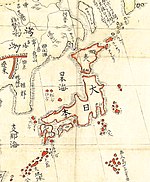Asuka period
| History of Japan |
|---|
 |
|
The Asuka period (飛鳥時代, Asuka jidai), sometimes called Suikochō-jidai ("period of the Suiko court"), was a time in the history of Japan which lasted from around 538 through about 710.[1] There is some overlap with the Kofun period which came before. There is also some overlap with the Nara period, which comes after.
The Asuka period is named after the Asuka region, about 25 km south to the modern city of Nara.
Timeline
- 538: Introduction of Buddhism from China via Korean peninsula[2]
- 593: Prince Shōtoku is regent for Empress Suiko[2]
- 600: Yamato state sends the first Japanese diplomatic mission to China[2]
- 607: Prince Shōtoku builds the Buddhist temple Hōryūji in Ikaruga.
- 645 (Taika 1): Emperor Kōtoku moves his capital from Asuka to Naniwa near the Bay of Osaka.[3]
- 645 (Taika 1): Taika Reform and the establishment of provinces[2]
- 672: Prince Ōama, later Emperor Temmu usurped the throne by winning the civil war (Jinshin no Ran) against Emperor Kōbun.
- 701 (Taihō 1): Code of Taihō was proclaimed.[2]
- 708 (Keiun 5): A mint was established in the province of Ōmi.[4] The mint made coins which are recognized as the first Japanese currency.[5]
- 710 (Wadō 3, 3rd month): Empress Gemmei established her new capital in Nara, which was known then as Heijō-kyō.[4]
Gallery
-
Wadōkaichin coin, minted starting in 708
Related pages
References
- ↑ Nussbaum, Louis-Frédéric. (2002). "Asuka-jidai" in Japan Encyclopedia, p. 59.
- ↑ 2.0 2.1 2.2 2.3 2.4 Hall. John Whitney. (1991). Japan: From Prehistory to Modern Times, p. 538.
- ↑ Brown, Delmer. (1979). Gukanshō, p. 266; Osaka City website: Archived 2009-03-06 at the Wayback Machine Osaka, history Archived 2007-11-06 at the Wayback Machine
- ↑ 4.0 4.1 Ponsonby-Fane, Richard. (1959). The Imperial House of Japan, p. 56.
- ↑ Japan Mint Museum Wado Kaichin Archived 2007-05-10 at the Wayback Machine. Retrieved 2012-4-29.
Other websites
![]() Media related to Asuka period at Wikimedia Commons
Media related to Asuka period at Wikimedia Commons
- Metropolitan Museum of Art, Asuka and Nara Periods
- Japan-guide.com, Early Japan
